
Which kind of glue should I use to produce a wood flooring or a wood cladding for the outdoor?
What requirements shall the adhesive meet?
Until a few months ago, these simple questions would not have had a clear technical answer, because there was no standard supporting these answers.
Indeed the standards and products for structural applications were often used in these wood industry fields.
At the end of a long experimentation activity, interlaboratory tests, comparisons between the experiences of various European countries, the working group WG12 of CEN/TC193/SC1 on November 10th, 2022 completed the formal procedure for the publication of the standard “EN 17619 Classification of wood adhesives for non-structural timber products for exterior use”.This new document establishes a classification of wood adhesives for non-structural applications for exterior use.
The standard provides three durability classes:
- XT5: Exterior application with rare exposure to direct weathering, in which the glued wooden product is covered by constructive protection from the weather. (e.g. wooden products behind cladding and products completely protected by roofs, coverings, canopy or open sheds, etc)
- XT6: Exterior application with occasional but not persistent exposure to the direct weathering, in which the glued wooden product is partially covered by constructive protection.
- XT7: Exterior application with frequent exposure to the direct weathering, in which the glued wooden product is not covered by constructive protection and not in contact with the ground (e.g.: decking, outdoor playground equipment and urban furniture, etc)
and the related performance requirements that the adhesive shall reach in order to achieve one of these three classes.
The adhesive performance are determined by means of a tensile shear test, at the end of two separate conditioning sequences:
1) Immersion in boiling water for 24 hours followed by 1 hour of cooling in water at 20°C
2) 1 hour in oven at 110 °C
The adhesive shall meet two tensile shear strength requirements at the meantime; for wet and hot conditions respectively.
The second standard plublished entitled “EN 17618:2022 Adhesives - Wood-to-wood adhesive bonds for non-structural applications - Determination of shear strength by compressive loading” specifies a method for determining the shear strength and wood failure percentage of wood-to-wood adhesive bonds loaded in compression.
These parameters allow to define different working properties of adhesives e.g.: final bond strength, pressing time, closed assembly time, etc therefore it could be used for the factory production controls or to assess the bonding quality of the adhesives.
Interesting are the following issues:
- the possibility offered by the standard to use any type of wood for the test (after its characterization of
.png?v3.4.3) course)
course)
and
- the photographic support useful tool for the wood failure assessment (an example aside).
In conclusion these new standards want to be a useful support both the sector of adhesive manufacturers and users.
Adhesives for furniture, but not only....
We would like to remind you that our Mechanical Testing Department deals every day with the physical-mechanical characterization of every type of material used along the production chain:
wood and panels derived from it, foams, fabrics, plastics and composite materials, ....
Every day we expand the range of products we are able to test precisely because of the requests we receive from our client companies.
Learn about our expertise and specializations: click here and propose your need.
We will be glad to evaluate the testing program that is right for you!
|
For info:Paolo Tirelli
0432 747246
tirelli@catas.com




.png?v3.4.3) course)
course)